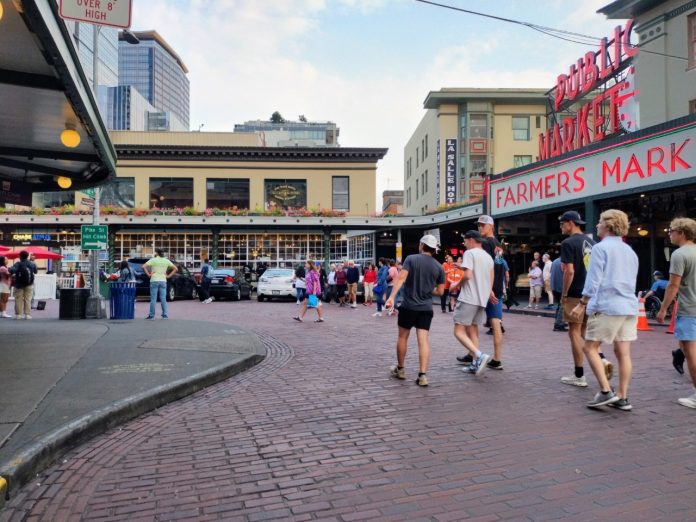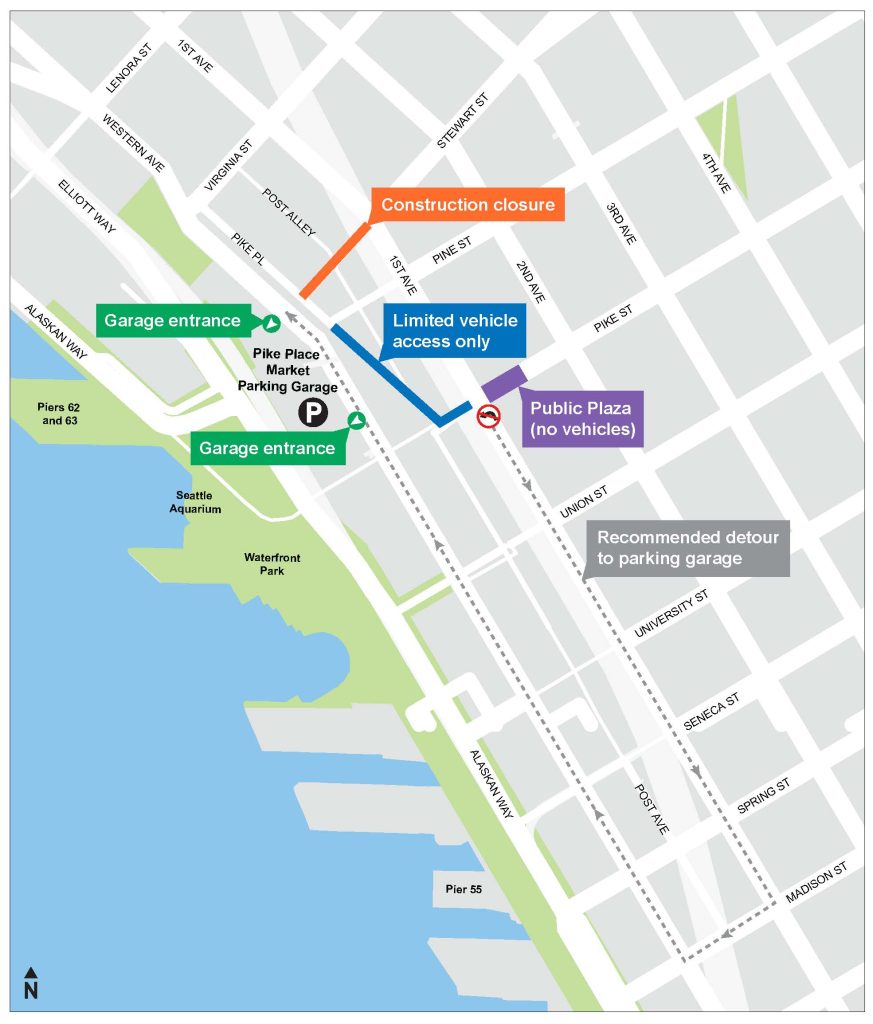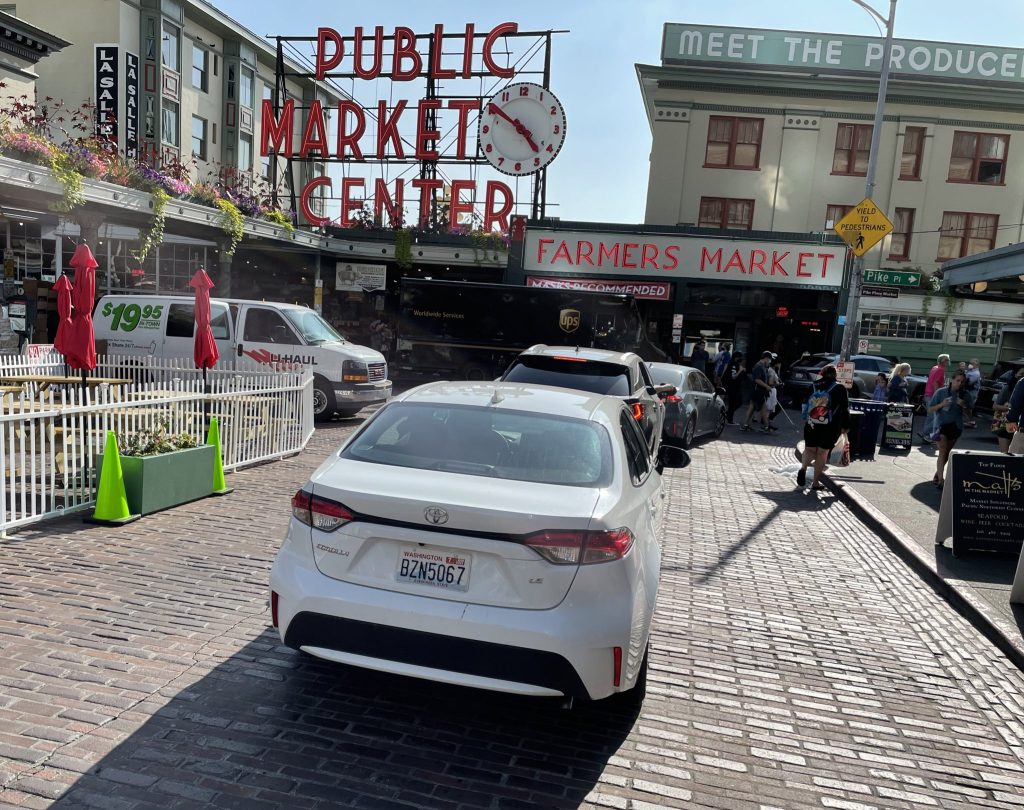
Starting Wednesday, Pike Place Market will take a major step toward realizing a goal held by many Seattle urbanists: banning most car traffic from the Market’s main corridor. Prompted by major utility work expected to last through July, traffic along Pike Place between Pike and Pine Streets will be limited to commercial deliveries, business loading access, emergency vehicles, drivers with disabled parking permits, and customers using curbside pickup for orders made in advance.
The Pike Place Public Development Authority (PDA), the nonprofit that manages day-to-day operations inside the Market, is calling the strategy an immediate effort to support the small businesses, but also a part of a broader “test and learn” strategy that will influence the conversation regarding longer-term changes to how Market access is managed.
The fact that drivers are able to drive down Pike Place at any time of day has long been frustrating to Market visitors, especially those that have visited other public markets around the world where pedestrianized streets with vehicle restrictions are commonplace. The presence of a long stream of cars forces people walking along Pike Place onto the edges of the street, which are already crowded with queuing patrons or folks pausing for a photo opportunity, adding stress into an otherwise enjoyable experience.
As part of the pilot, the Seattle Department of Transportation (SDOT) will station a flagger at First Avenue and Pike Street, only allowing drivers with an access pass to turn into the Market. While likely not a long-term solution, it will provide a real test of how the Market performs with limited car traffic. People on bikes will still be able to use the full corridor.
“This limited vehicle access pilot is not a full street closure. It allows authorized vehicles to access Pike Place and restricts non-essential traffic — such as visitor pass-throughs and rideshares — access at 1st and Pike,” the PDA said in a release early Tuesday. “This pilot is intended to preserve essential street functions for the business and residential community while increasing safety and reducing congestion.”

Vehicle access along Pike Place has been a simmering issues for years, but has taken on increased salience since a January 1 terrorist attack in New Orleans, in which a 42-year-old American man used a pickup truck as a weapon along partially pedestrianized Bourbon Street. Ahead of the 2026 FIFA World Cup, the Harrell Administration has been making moves to look at potential infrastructure changes that could reduce the likelihood of a similar vehicular attack in Seattle, including in locations like Pike Place Market and Seattle Center. Mayor Bruce Harrell teased that a Pike Place pedestrianization pilot could be on the way during his annual State of the City speech in February.
Pike Place was the site of a road rage brawl in 2022 that seriously injured a pedestrian, though the event was shrugged off and did not galvanize action at the time.
A brand new Pike Place Master Plan, adopted by the PDA in 2024, calls for the creation of a “comprehensive street management program” that will look at Market access. “The street must be managed differently to respond to varying seasonal and time-of-day use, deliveries and set up, and supporting the functional needs of the Market – while ensuring that Pike Place supports the Market experience for vendors and customers,” that plan states.

But making changes has already been easier said than done, with competing interest groups — including the Market Historical Commission, which approves any changes to the historic district — holding strong opinions about maintaining direct vehicle access.
The safe streets advocacy nonprofit Seattle Neighborhood Greenways has been one of the biggest proponents of rethinking how Pike Place operates, sponsoring a 2023 survey that found that most Market vendors are open to the idea of pedestrianizing the street. Seattle Greenways co-sponsored public polling in 2021 that found Seattleites overwhelmingly (81%) favor pedestrianizing Pike Place
“We applaud the city’s move to test better management of Pike Place for everyone — people walking, rolling, loading/unloading goods, and shopping,” Greenways Executive Director Gordon Padelford said of the move.
Seattle Greenways sees pedestrianization as a win-win that makes the Market more vibrant.
“By restricting non-essential traffic, the market will create enhanced access for loading, unloading, ADA, and emergency services, and open up new possibilities for market patrons and vendors,” Padelford continued. “Ideas that could be tested this summer include adding stalls for vendors and farmers, public seating, art or music stands, improving visibility for businesses, and temporary events such as cooking demonstrations.”

Earlier this month, the Pike Place Constituency, a group that describes itself as representing “the public’s voice at the Market,” approved a letter officially asking the PDA to move forward with restrictions on through traffic along Pike Place. The vote was a big move for one of the biggest advisory groups within the Market bureaucracy.
“[T]he Constituency calls for the PDA to enact policy to reduce personal vehicle traffic in the market while being mindful of business delivery needs, EMS [emergency medical services] access, and access for disabled visitors,” the letter stated. “By limiting non-essential vehicle access, we can streamline deliveries, facilitate emergency response, and reduce congestion. This improvement can ensure a smoother operational flow and help businesses, crafters, and farmers thrive.”
District 7 Councilmember Bob Kettle, who jumped into the fray around Pike Place last year with an amendment to the Seattle Transportation Plan preventing any street updates from being funded in the city’s transportation levy, offered praise for the move Tuesday. Earlier this year, Kettle organized a meeting of Pike Place stakeholders, which seemed to be another factor pushing things in a positive direction.
“Pike Place Market is a living, working part of our city, and I’ve always believed that decisions about its future should be shaped by the people who know it best — the Market community itself,” Kettle said in a statement. “This pilot reflects that thoughtful, community-driven approach. It’s a smart step forward to better understand how we can preserve essential functions, reduce congestion, promote safety, and keep the street working for the people who rely on it every day. As we test and learn, I’m committed to staying connected with the Market.”
While the move is only temporary, it does represent the first real progress toward resolving a problem that for a long time looked to be intractable. But now it looks like a compromise that works for all Market visitors just might be possible.
Ryan Packer has been writing for The Urbanist since 2015, and currently reports full-time as Contributing Editor. Their beats are transportation, land use, public space, traffic safety, and obscure community meetings. Packer has also reported for other regional outlets including Capitol Hill Seattle, BikePortland, Seattle Met, and PubliCola. They live in the Capitol Hill neighborhood of Seattle.


